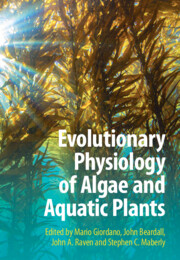Book contents
- Evolutionary Physiology of Algae and Aquatic Plants
- Evolutionary Physiology of Algae and Aquatic Plants
- Copyright page
- Contents
- Contributors
- Preface
- Acknowledgments
- 1 Environmental Changes Impacting on, and Caused by, the Evolution of Photosynthetic Organisms
- Part I Origins and Consequences of Early Photosynthetic Organisms
- Part II Physiology of Photosynthetic Autotrophs in Present-Day Environments
- Part III The Future
- 15 Aquatic Phototrophs and the Greenhouse Effect
- 16 Ultraviolet Radiation Effects under Climate Change
- 17 Variation in Nutrient Availability for Aquatic Phototrophs and Its Ecological Consequences
- 18 Algae: New Products and Applications
- Index
- References
18 - Algae: New Products and Applications
from Part III - The Future
Published online by Cambridge University Press: 24 October 2024
- Evolutionary Physiology of Algae and Aquatic Plants
- Evolutionary Physiology of Algae and Aquatic Plants
- Copyright page
- Contents
- Contributors
- Preface
- Acknowledgments
- 1 Environmental Changes Impacting on, and Caused by, the Evolution of Photosynthetic Organisms
- Part I Origins and Consequences of Early Photosynthetic Organisms
- Part II Physiology of Photosynthetic Autotrophs in Present-Day Environments
- Part III The Future
- 15 Aquatic Phototrophs and the Greenhouse Effect
- 16 Ultraviolet Radiation Effects under Climate Change
- 17 Variation in Nutrient Availability for Aquatic Phototrophs and Its Ecological Consequences
- 18 Algae: New Products and Applications
- Index
- References
Summary
In addition to the current uses of algae as food and as sources of pigments and polysaccharides, there is potential for the further use of algae as sources of additional specific biomolecules. In addition to this, there is the possibility of the use of alga in a wide variety of processes such as bioenergy (production of liquid fuels and algal biophotovoltaic generation of electricity), removing pollutants from wastewater, and the production of plant growth enhancers and crop protection materials. The eventual commercialisation of these requires the processes to be scalable and economical. The targeted use of algae, other than as food sources, is less than 100 years old and our knowledge of algal biology, physiology and chemistry is still growing and only a very small number of algal species have been studied in detail. One of the main limitations is the need for more reliable, lower cost and larger-scale algae production systems and their development, in turn, requires a good understanding of basic algal biology and life histories. In addition, more work is needed on increasing the efficiency of light utilisation in photosynthesis and hence in growth.
Keywords
- Type
- Chapter
- Information
- Evolutionary Physiology of Algae and Aquatic Plants , pp. 369 - 386Publisher: Cambridge University PressPrint publication year: 2024

